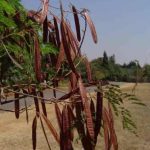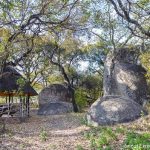TREE LIFE
September 2008
MASHONALAND CALENDAR
13 September (2nd Saturday): Talk on the Zimbabwe Flora website project. As part of the series of talks arranged by the Wildlife Society, Mark will be talking about the Zimbabwe Flora website, including demonstrating its capabilities and discussing progress to date. The venue is the Mukuvisi Woodlands education centre and the talk will begin at 2.30 p.m.
21 September (Sunday): Haka Game Park. A return visit to this interesting place quite close to the city. We expect to see some early-flowering trees and some of the spectacular ground flora. Bring a packed lunch and a chair. Time: 9.30 a.m.
Note that there will be a charge for entry. We have no up-to-date information at present, so come prepared! [Note: National Parks is now raising rates and prices every Monday, so phone them if in doubt. –Ed.]
27 September: 4th Saturday walk
The normal 4th Saturday walk clashes this month with the Mukuvisi Woodlands Association Festival. Arrangements for the involvement of the Tree Society have not yet been made and we will be sending out a separate email about that closer to the date.
MATABELELAND CALENDAR
Please contact Jean Wiley or Gill Short for details of the next Matabeleland function.
VISIT TO EWANRIGG: 17 AUGUST 2008
We assembled in the shade of the eucalypts at the farthest end of Ewanrigg and, after we were certain that all who were coming had arrived, we set off on a more-or-less random course. Meg Coates Palgrave had kindly agreed to lead us as Mark was suffering from an indisposition.
Ewanrigg is an interesting site because it reflects both the natural environment of the area and the passions and tastes of the previous owner. Originally, Ewanrigg was the farm and personal hobby garden of botanist Harold Basil Christian, who set up housekeeping on the site in 1891. It was named Ewanrigg (Manx for Ewan’s Ridge) after the family holdings on the Isle of Man. Upon Christian’s death in 1950, his holdings were bequeathed to the nation. Today, Ewanrigg still reflects both the modified and the natural environment.
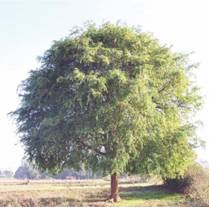
Tamarindus indica,. Photo: Wikipedia
Our first stop was a magnificent tamarind [Tamarindus indica], perhaps the finest specimen in the country. It certainly far excels the over-crowded tamarind in the National Botanic Gardens that struggles so to display its best qualities. A very handsome tree, the tamarind is, as Meg reminded us, native to tropical Africa, from where it is thought to have spread to India and thence to other parts of the world. [Interestingly, in their book Field Guide to Trees of Southern Africa, B. & P. van Wyk reverse the direction and state that the tamarind was “…most probably introduced from India into our region by traders many centuries ago.”] So precious was the tamarind that it was taken by the Spanish from India, where it has grown for centuries, to the West Indies and Mexico in the 17th century as trade. Since then it has become important in the culinary traditions of the West Indies and Mexico. The word tamarind comes from the Arabic word tamar-i-Hind — the date of India.
According to the well-known herbalist Margaret Roberts, the fruits of tamarind are used ripe and fresh or are dried and made into tamarind paste, which is sweet-sour and astringent. The fresh pods are used to make a tea to treat asthma, jaundice, fevers, dysentery, rheumatism, aching legs, arthritis, constipation, morning sickness, stomach ulcers and indigestion. A liquid of tamarind paste added to boiling water can also be sipped for these ailments. [Mark, this is just what you needed!]
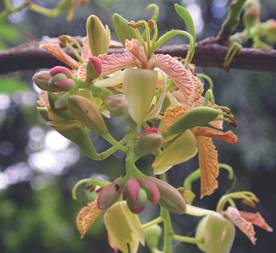
Tamarindus indica,flowers. Photo: Wikipedia
The boiled-up evergreen feathery compound leaves are used in the bath to wash infected grazes and rashes, and to bring down fevers.
The pulp is eaten either mashed and softened in hot water, or purified to a paste with sugar for its laxative effects. This pulp is added to many dishes to improve the appetite and to ease digestion. Interestingly, in the commercial food industry, tamarind, with its plant acids and high pectin content, is used in fruit drinks and chutneys, and even Worcestershire sauce. Tamarind in desserts and sweet dishes is superb. And the over-ripe fruit is used to polish silver, copper and brass. It is no wonder this striking tree is so respected and enjoyed wherever it grows.
For those enticed, propagation of tamarind is from seed. The trees thrive in full sun in hot areas that never have temperatures below freezing, in well-drained sandy soil.
Although the aquatic plantings, and stream-side plantings, at Ewanrigg have suffered badly from the inability to pump water regularly, the large herb garden, modelled on the medieval herb wheel, seems to have been watered regularly and displays an interesting variety of herbs. What appears to have suffered most is the plants in the area dedicated to hybrid aloes created by the Aloe Society some years ago. Most of these hybrids have now disappeared, raising the question of whether the hybrids are as robust under adverse conditions as are their distinctive parents.
One can also imagine that, being water-lovers, the Hyphaene petersiana and the massive Raphia australis we saw are growing increasingly stressed because water is no longer being pumped. In any event, the R. australis had flowered and set fruit, so it will soon die.
Ewanrigg is a modified, and somewhat eccentric, ecosystem. Sizeable areas, obviously cleared in the past, are now regenerating under overcrowded Brachystegia spp. and others, either self-seeded or regrowing from unremoved stumps. In the areas which had not been cleared in the past, we saw Acacia amythethophylla, Pittosporum viridiflorum and Vernonia colorata, among others. On the fringes of these areas, however, we saw exotics such as Calliandra and the ubiquitous Bougainvillea.
All in all, it was a very pleasant day and well worth the drive. Thanks, Meg. We were all heartened to see that Ewanrigg was in better condition than we had expected. The larger areas of grass had all been mowed, and the grass among the aloes and other specimen plants had been slashed. National Parks is clearly doing their best in very difficult circumstances.
Bill Kinsey
TREE LIFE BACK NUMBERS
John Shaw has a complete run of the newsletter Tree Life from no. 121 (March 1990) to no. 286 (January 2004). If anyone is interested in acquiring these, please contact John directly on Harare 496020.
FORESTRY IN ETHIOPIA [This contribution is by former Tree Society member, Michel Laverdière, now an FAO Forestry Officer in Addis Ababa, Ethiopia.
-Ed.]
Setting
Ethiopia is a land-locked country located in the northeastern part of the horn of Africa between 30 and 150 N latitudes and 330 and 480 E longitudes. Altitudes vary from -125 m in the Afar depression to 4620 m at the Ras Dajen summit. There are 17 agro-climatic regions.
Forest Facts
About 11.9 percent of Ethiopia’s land area is forested (13 million hectares). Another 44.6 million hectares are under other wooded land. The remaining natural high forests include various types of montane forests concentrated in the less-populated and western parts of the country. The central and northern parts are almost completely deforested. Humid, mixed forests occur in southern Ethiopia, with trees species like Podocarpus, Croton, Olea and Hagenia at higher altitudes. In the southwest, broad-leaved forests are common. Bamboo is also found in clumps within the high forests. Two species of bamboo are indigenous to Ethiopia and cover about a million hectares, equivalent to some two-thirds of the entire African bamboo forest area. These are found mainly in the southwest, south and central parts of the country.
Forest plantations cover 491 000 ha, but the rate of plantation development is low and has stagnated. Of the total, 95 000 ha are industrial plantations, 35 000 ha are periurban plantations, 20 000 ha are community woodlots and 50 000 ha are catchments or protection plantations. The most planted species are eucalypt, cypress and pine. There are nowadays a few efforts to convert eucalypt forests back to indigenous woodland. For instance, the Ethiopian Heritage Trust has been charged by the government to reclaim Mount Ntoto, an important watershed for Addis Ababa. The Trust progressively eradicates eucalypts and replaces them by local highland species such as Hagenia abyssinica, Juniperus procera and other local species. There are also initiatives to plant olives (Olea europea) in the proximity of Lalibela, a holy city of orthodox faith and famous for its medieval rock-hewn churches. Many churches still have centuries-old front doors and furniture made of the African subspecies of the olive tree, Olea europaea subsp. cuspidata (also known as Olea africana).
The lowland woodlands are largely restricted to the agro-pastoral and pastoral zones. The woodlands include species of various acacia, including A. senegal, producing gum arabic, Boswellia, the frankincense tree, Commiphora, Combretum and Croton.
Forests and their Management
Poor management, encroachment and illegal cutting have reduced the growing stock to well below the desirable level. It is therefore assumed that annual yields are 60 percent of what should be expected under proper management.
Every year, very large areas of lowland forests and grassland are affected by fire, particularly in the drier parts of the country just before the short rainy season. There are no available statistics on the causes of fires, risks or extent of damage by forest fire, but losses due to wildfire (human lives, herds, flocks and crops) represent a significant fraction of total GDP. Communities relying on forest products and timber production are also severely affected.
Average annual industrial roundwood production is about three million cubic metres; this includes wood used for local housing, fencing and furniture production and industrial wood products such as lumber, plywood, fiberboard and particleboard. Ethiopia’s industrial wood production and consumption per capita are among the lowest in the world, reflecting the fact that the country’s limited forest resource base has been and continues to be primarily exploited for fuelwood. Indeed the energy sector of Ethiopia remains heavily dependent on wood for fuel. Over 80 percent of the country’s total energy for household cooking is derived from wood fuel.
Gums and incense, among some of the non-wood forest products, used to be important export products, but Ethiopia has not performed well as a supplier because of a dwindling raw material supply. About 1 500 mt of gums and incense are sold annually through official trading channels, of which nearly 50 percent is exported. The demand for incense exceeds the supply, and prices are increasing.
There is an ancient tradition of beekeeping in Ethiopia. The density of hives is estimated to be the highest on the African continent. The honey is almost exclusively used for local consumption, while a considerable proportion of the wax is exported.
An incongruous conifer in a continent of hardwoods
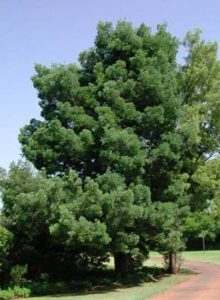
Podocarpus falcatus (East African Yellowwood) Photo: Wikipedia
Podocarpus falcatus (East African Yellowwood) is an evergreen tree from the Podocarpaceae family. It is a large tree of the semi-humid lower highland forests of the central and eastern highlands of Ethiopia, found at altitudes ranging from 1500 to 2500 m. The species is slow-growing but hardy once established. Its uses include firewood, timber for furniture, boxes, plywood and panels, poles, and medicine is extracted from its bark. It is also good for shade and as an ornamental.
Challenges of Forest Management
The key problems facing conservation efforts are land-use conflicts with the local people. The responsible department is weak and poorly equipped to carry out the tasks entrusted to it and powerless to enforce regulations due to lack of trained staff.
Another important challenge is the recurrence of bush and forest fires. Every year millions of hectares are burnt due to agricultural practices or clearing fires that escape control. The country is examining the possibilities to reduce fire risks and improve early warning systems and is concentrating on priority areas of high-value forests like plantations and high forests.
The Coptic Church and forest conservation
“… In most parts of Ethiopia, particularly in the northern regions, churches or monasteries are the only places where indigenous trees or forests can be seen. In much of the landscape of northern Ethiopia, the lush vegetation on the sides of a hill surrounding a church or a monastery presents a sharp contrast to the surrounding ridges and mountain slopes: it is the only locality covered by tree vegetation and not affected by gully erosion… Wanza (Cordia africana), dokma (Strychnos spinosa), shola (Ficus capensis), and many other species are abundantly found…” K. K. Merahi
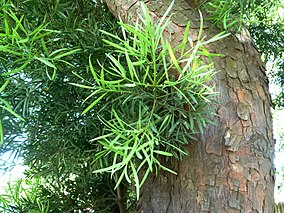
Podocarpus falcatus (East African Yellowwood) leaves and bark. Photo: Wikipedia
Ethiopia is also in need of updated information about its forest resources. It has benefited from a Woody Biomass Inventory Project, but the information provided is already dated, and new data are needed. The country is now exploring ways and means to review its land use and forest inventories, especially in priority areas. Since information is lacking on the management of these resources, it will be important to develop capacities to promote conservation and management of the resources for sustained production focusing on better protection and utilization.
The Bale Mountains Reserve
The Bale Mountains, ranging between 4000 and 4100 m, are located southeast of Addis Ababa. An extensive plateau supporting afro-alpine vegetation, the mountains have many lakes and closed forests, which vary in composition depending on slope, aspect and micro-climate. Juniperus, Podocarpus and Hagenia dominate the slopes, with numerous endemic species. The forest is the second largest natural forest block in Ethiopia, and its extent and wide diversity mean that it is among the most important conservation areas in the country. It is important also for animal species, which include 64 known mammalian species, 11 of which are endemic.
A sustainable land management project began in mid-2006 and aims at supporting efforts on sustainable poverty reduction through protection and conservation of natural resources, including forestry, soil and water conservation, agroforestry and land certification. The project was developed to complement existing activities in the Kaffa Zone in forested southern Ethiopia, the area where coffee is found growing naturally and the original home of Coffea arabica.
Conclusion
While forestry in Ethiopia needs to be more visible as a priority and through its institutions, there is capacity to provide sound policy-making and leadership. There are also many foresters working for NGOs and other government ministries who have important expertise in forest land use and management. The private sector is also progressively expanding, implying the development of more processing capacities.
The big challenge remains to engage nearly 80 million citizens in sustainable land and forest management practices. They will do so, however, only if they can achieve a reasonable return from services and goods derived from the forest and from trees.
Further reading:
Bekele, M. 2007. Review of Forestry in Ethiopia. Addis Ababa: FAO
Bekele-Tesemma, A. 2007. Useful Trees and Shrubs for Ethiopia. Technical Manual no 6. Nairobi, Kenya: World Agroforestry Centre
Merahi, K. K. 2001. Saints and Monasteries in Ethiopia. Addis Ababa: Commercial Printing Enterprises


